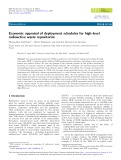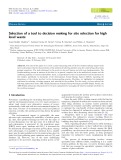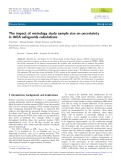
REGULAR ARTICLE
Selection of a tool to decision making for site selection for high
level waste
Jonni Guiller Madeira
1*
, Antônio Carlos M. Alvim
2
, Vivian B. Martins
2
, and Nilton A. Monteiro
2
1
Celso Suckow Fonseca Federal Center for Technological Education–(CEFET), Areal street, 522 Sq. Mambucaba, Angra dos
Reis, Brazil
2
Nuclear engineering program–(PEN/UFRJ/COPPE-RJ), Federal University of Rio de Janeiro, Horácio Macedo avenue 2030,
Technology Center Building, University City, 21941-972 Rio de Janeiro, Brazil
Received: 25 May 2015 / Accepted: 27 November 2015
Published online: 10 February 2016
Abstract. The aim of this paper is to create a panel comparing some of the key decision-making support tools
used in situations with the characteristics of the problem of selecting suitable areas for constructing a final deep
geologic repository. The tools addressed in this work are also well known and with easy implementation. The
decision-making process in matters of this kind is, in general, complex due to its multicriteria nature and the
conflicting opinions of various stakeholders. Thus, a comprehensive study was performed with the literature in
this subject, specifically in documents of the International Atomic Energy Agency (IAEA), regarding the
importance of the criteria involved in the decision-making process. Therefore, we highlighted six judgment
attributes for selecting a decision support tool, suitable for the problem. For this study, we have selected the
following multicriteria tools: AHP, Delphi, Brainstorm, Nominal Group Technique and AHP-Delphi. Finally, the
AHP-Delphi method has demonstrated to be more appropriate for managing the inherent multiple attributes to
the problem proposed.
1 Introduction
Nowadays, considering the increasing demand for power,
and the environmental issues, it is ever more necessary to
adopt (and create) new alternative sources of power,
economically viable and with low environmental impact. In
this sense, because of environmental, social and political
concerns, recently, the nuclear power has drawn the global
attention.
The environmental impact is potentially the most
relevant topic concerning the suitability of nuclear power
[1]. And, since global warming has been the key topic of
several discussions over the last years (it is believed that
such phenomena is generated by the greenhouse gases
[GHG]: water vapor, methane and CO
2
), it increases the
environmental advantages of nuclear power plants. Among
such advantages, it is possible to mention that a smaller
space may be quite satisfactory for its construction, also it is
quite free from polluting gases emissions such as CO
2
and
methane [2]. However, one of the most challenging
questions to be answered, regarding nuclear power, is the
appropriate location for nuclear power plants construction
and location for nuclear wastes.
Since the early 1970’s, a rising concern with the final (or
temporary) disposal of radioactive wastes has been noticed.
This rising attention on nuclear wastes questions has
generated an economic and safety assessment that sought
to optimize the cost-benefit of these repositories (storage
location for disposal of radioactive wastes). Also, several
authors have been discussing about this issue [3–14].
Altogether, there is not many countries with final
repositories (for radioactive wastes) working. However,
some countries, as Finland, e.g., are making a great progress
building deep final repositories [14].
Thus, regarding the place selection for safely housing a
deep geological repository, we have walked into a decision-
making issue, since we need to choose, among the likely
possibilities, one that meets the several points required for;
and also that best fits these points, as deep geological
repository for radioactive waste, emphasizing the spent
fuel.
The process of decision-making involves various
specialties from different fields, considering it is a multi-
criteria problem. In this case, we need a decision support
tool that can arrange the specialists’opinions within the
context of place selection.
* e-mail: guiller.nuclear@ufrj.br
EPJ Nuclear Sci. Technol. 2, 6 (2016)
©J. Guiller Madeira et al., published by EDP Sciences, 2016
DOI: 10.1051/epjn/e2015-50039-x
Nuclear
Sciences
& Technologies
Available online at:
http://www.epj-n.org
This is an Open Access article distributed under the terms of the Creative Commons Attribution License (http://creativecommons.org/licenses/by/4.0),
which permits unrestricted use, distribution, and reproduction in any medium, provided the original work is properly cited.























